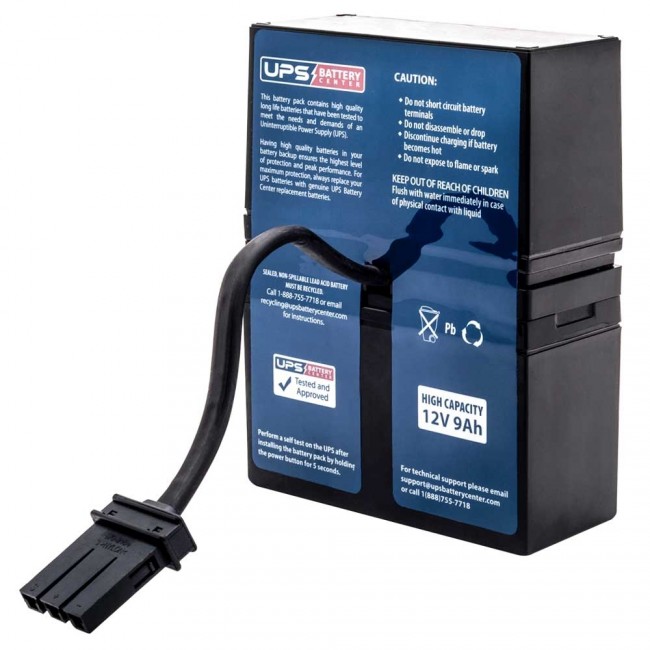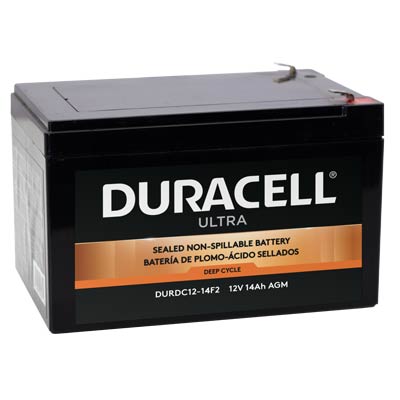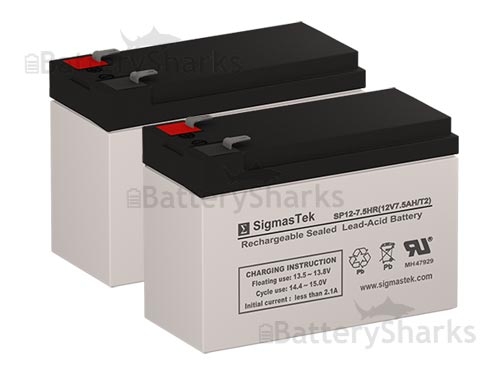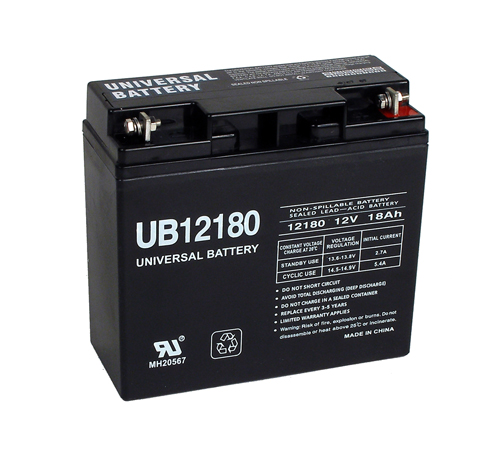
12VDC 9Ah Battery for 1500VA UPS
What do the numbers really mean?
This is an argument that goes on and on and you can dispute and debate it all you want, I am always right. I've studied this matter extensively and even been certified. So you want to argue? You just lost because I don't have a comments section :-p
So let's look at some of this stuff by jumping right in. I've seen UPS' that all have the same VA (Volt-Amps) ratings but the output Wattage are all different. I even had a discussion with a customer one time when I advised them that an 1100 VA desktop computer UPS was only delivering between 400-650 Watts, they said "Uh no? VA means Volts times Amps, you know I work in IT too, right?". So by that the customer was intending to say that VA's = Watts delivered. So by that logic, 1100VA = 1100 Watts. SO given that this UPS should last roughly about an hour under a 1kW load (also not true). So of course being the prick I am I said "Oh so then you know that VA's are the 'Apparent Power', which denotes the total power produced by the system and not the actual output power delivered to the connected devices" to which, he ended the discussion. That UPS was supporting 2x 500 Watt PoE switches. A month later they lost power and the switches died in under a minute. Go figure. If they wanted 1 hour battery backup, they would be paying quite a bit more than $79 for their UPS.
So then, wtf is the deal? If you followed my ramblings you read Electricity 101 (Voltage, Amperage and Power) and learned that Volts * Amps (Current) = Watts (Power). But in a circuit, this is known as Apparent Power, represented as VA. In all matters of energy, there is a matter of loss by means of various factors. One of the most common factors with electronics is heat dissipation. The goal of the electrical circuit is not to create heat (unless it's an electric heater, then you're battin' a thousand bruh), it's the function of the circuit. To this extent there is 3 factors we look at.
1. Apparent Power. This is the theoretical amount of Power (VA) delivered by the device.
2. Reactive Power. This is the amount of Power "lost" (VAR) in the device.
3. True/Real/Active Power. This is the actual Power (Watts) being delivered by the device.
So lemme explain a bit. When you have a UPS, it states it is 1500VA. That is the theorectical amount of power that the UPS could deliver. So the UPS takes the AC Input Power and converts it to DC Power where it then uses a Battery Management System (BMS) to charge the internal battery. Sometimes it is a single battery with multiple cells and something it is multiple battery cells interconnected (battery bank). Regardless whether it's a single battery or a battery bank the BMS manages the task of monitoring and charging the battery bank. It is also responsible for periodically applying a load to the battery bank in order to allow it to discharge in order to keep it at peak performance. Different chemistry types of batteries are available but most commonly battery banks use AGM batteries which are layers of fiberglass matting flooded with Lead-acid between. These are self-maintained batteries.
Sadly I do not have any old batteries laying around. I try to recycle my batteries but I did find some pics online I can show you for demonstration purposes.

12VDC 9Ah Battery for 1500VA UPS

12VDC 14Ah Battery for 1500VA UPS

12VDC 7.5Ah

12VDC 18Ah
The UPS does some work to convert the power in another circuit called an Inverter. The Inverter actually does 2 jobs, it first upconverts the Voltage from 12VDC to 120VDC using a Boost Converter then it converts the DC to AC Voltage. In larger more commercial applications, conversion works by using an Line-Frequency Transformer to convert the DC to AC at the battery level then using a transformer to step-up the voltage. It is at this point that we measure the True/Real/Active Power. Since the inverter no matter what will see 1500VA, if the inverter is not very efficient, the output Power may be lower than the VA rating. Typically Boost to Inverter (I refer to them as B2I) are less efficient than Line-Frequency Transformer (again I refer to them as LFT). LFT's typically have better than 85% efficiency while B2I is above 70%. Oh? Oh really? Yea. Let's take a looksie at 2 different types of 1500VA UPS systems.
APC Back UPS PRO BR 1500VA Model BR1500MS
900 Watts = 60% Efficiency
APC Smart-UPS SRT 1500VA Model SRT1500XLA
1.35kW = 90% Efficiency
Ok so I was wrong, not 70% .... 60% !!!! Even worse! Now don't misunderstand it's not JUST the conversion method, it's also the battery. These 2 units have entirely different batteries. The BR1500MS has a 2x 12VDC 3.2Ah batteries and the SRT1500XLA has 8x 12VDC 5Ah batteries. Obviously the SRT1500XLA costs much more (nearly 10 times the cost) of the BR1500MS. But you want a better product, you need to believe that a better product comes with a higher price tag.
One more thing to think about. The BR1500MS delivers 24VDC @ 3.2Ah which means the batteries are wired in series. The SRT1500XLA is 4S2P which means 4 batteries are in series making a 48VDC @ 5Ah single battery, combined with another pack just like that one wired in parallel to the first, giving a final rating of 48VDC @ 10Ah battery. Yah, huge difference. Not only do you get more power, but the Ah rating is higher which means it will last a bit longer.
To compare the 2 UPS systems you would need to do a bit of math. Let's say the BR1500MS, full charge you pull the plug then you put a 90 Watt bulb on there. That's 10% of the total output power. That's a 10% load. Now the SRT1500XLA, same thing except let's put 2-70 Watt bulbs on there which consumes 140 Watts. Again, 10% load. Now just let them run. I guarantee the SRT1500XLA will outlast the BR1500MS by more than 3 times the duration.
Long story short, you really need to understand how these units work in order to know what you are getting. Sadly as consumers we are thrown these units in the stores, BJ's, Home Depot, Wal-Mart, Amazon and we simply look at this "One Bajillizion VA's for $79.99 - regular price, $129.99" and think "whoa! what a deal" - yea for the retailer. Don't be fooled and don't BE a fool! Next question . . I love this one . . Why oh why should you listen to me? Companies, large organizations, Data Centers (ie; Internet Back Bones), you know, the guys who's computers are still working even when your UPS' fail? you know them right? They hire consultants who are trained and certified in knowing this stuff. Yup you guess it, I am one of them. Sure my background before learning this stuff was strong, but understanding the technology that goes into these products are mind blowing. Not in contrast but in compliment I've also been working with Solar Power for a while and although there are some considerable differences between them, they are not far off. Battery types, battery capacity, Inverter types, same rule applies. Crappy inverters give you crappy results. Poorly designed battery banks give you lower output.
So when you need to get a new UPS, I will first recommend getting a Kill-a-watt (or similar device) which is a meter you plug into your outlet then you plug in a power strip to it then all the devices you want to provide battery backup for. Set it to show you Power (Wattage). Then it will show yo how many Watts per hour your devices are consuming. Then you multiple the Wattage by the number of hours you want to provide backup power for (do NOT be ridiculous and say 12 hours). Say, 1 hour - maybe 2. Then add 25% to that result. So if you have 300 Watts on the meter and you want 2 hours protection, get a UPS that will provide at least 750 (300*2)+25% = 750 Watts and now you know how many Watts your UPS should be.
What is also important to keep in mind that while the UPS may state 900 Watts, that's 900 Watts delivered from the battery-side of the UPS. This means at any one moment, the UPS can deliver up to 900 Watts. So this UPS may have 6 outlets for Battery and 6 outlets for surge protection. The 6 outlets are all sharing the 900 Watts. So 900/6 = 150 Watts per outlet. The battery is 12VDC so 150/12 = 12.5Amps. Am I sure about this? No but I have tested APC, Tripp-Lite and CyberPower UPS systems and put some serious loads on them and found that under load, they will fail when they get near the current ratings I was looking for, therefore I must e right, yah? YAH?? Well maybe not exactly but I am certain that the manufacturer is NOT going to tell us much about that.
I started to mention this earlier. The output Wattage has NOTHING to do with the capacity of the UPS. By this I mean that a 900 Watt UPS cannot handle a 900 Watt load for 1 hour. In other words, it is NOT a 900Wh UPS. I wrote another ramlbing about this "Electricity 103 (Collection, Storage and Capacity)" which spells out this problem as well.
Now the fun stuff. Stories I can tell you from being on the job.
On the lighter side, one customer has the following items which need battery backup: Firewall 35 Watts, phone system 325 Watts, Network Monitor 300 Watts, network switch 750 Watts, network switch 80 Watts, network switch 110 Watts, Server 1650 Watts with a total 3,250 Watts. They said "yea give me an hour - maybe an hour and a half" so they have a 5kW (that's 5,000 Watts) UPS. It's massive. It costs about $7,000. It gives them 90 minutes of battery backup time. And you know what? They love it.
Another customer, they have a computer, a phone, a monitor, laser printer all connected to a power strip. I measured it all with a Kill-a-Watt meter and it came out to 410 Watts. I made a call and it moved to 415 Watts. I printed a document and it jumped to 883 Watts. They had a 350VA UPS. This unit provided enough power for about 45 seconds during a full operation with all things going, about 2 minutes if they were not printing. Why? Guess......
And finally the creme de la creme . . Piece du resistance . . Soup de jour
3-500 Watt network switches, a 90 Watt firewall, a 1200 Watt server, a 2400 Watt server, a 210 Watt KVM and a 450VA battery backup with the customer saying "Why what's wrong with this? The guy at Best Buy said it would be fine".